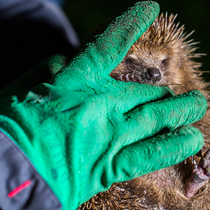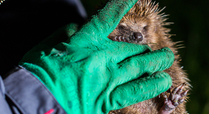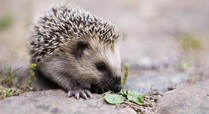Hedgehogs in The Regent's Park
Did you know that hedgehogs still live in The Regent’s Park?
 Hedgehogs are one of the nation’s favourite species, yet there’s been a worrying nationwide decline in hedgehog numbers in the last 25 years and The Regent’s Park is now the only central London Royal Park with a breeding population.
Hedgehogs are one of the nation’s favourite species, yet there’s been a worrying nationwide decline in hedgehog numbers in the last 25 years and The Regent’s Park is now the only central London Royal Park with a breeding population.
With the help of top wildlife scientists and over 100 volunteers, we discovered a small population of around 40-50 animals living and breeding in the Park in 2014. Our hedgehog team returned to The Regent’s Park in May this year to see how the vulnerable population has fared over the winter and find out more about their nocturnal activities.
Our research
We're working with The Royal Parks, The Zoological Society of London (ZSL), People's Trust for Endangered Species, the Central Royal Parks Wildlife Group, two eminent wildlife scientists and lots of amazing volunteers to survey the hedgehogs in Regent’s Park. We're aiming to find out all about this elusive nocturnal animal and help safeguard this precious population. Find our more about the scientific study and our research methods here.
Technology played a huge part in 2015’s study, with thermal imaging cameras being used, a rarity in these types of projects, along with radio tagging and GPS tracking. A DNA analysis of the hedgehogs’ spines is also planned for the summer to find out more about the genetic make-up of this small population.
What did we find in the Park?
- We found a small hedgehog population estimated to be around 40-50 individuals (which is really encouraging!). Young hoglets were also found in September 2014 confirming that the population had bred.
- The hedgehogs preferred to forage in short grassland within a mosaic of shrubberies and hedges. They avoided large areas of very short grass such as the sports pitches.
- They preferred to nest in areas of dense undergrowth where they could use brambles, fallen leaves and grass to build their expertly constructed homes
- The hedgehogs travelled up to 1.5 km, nearly one mile, per night – the equivalent of three stops on the Underground between Regent’s Park and The Angel, Islington!
- Our adult hedgehogs had an average body weight of 960g, above the national average. Which means there's evidently plenty of food to eat in the Park!
What's next?
- We've drawn up some habitat management recommendations so that the Regent's Park team can continue to maintain the Park in a ‘hedgehog-friendly’ way. These plans include letting the grassland adjacent to the hedges grow longer to provide a richer environment for hedgehog foraging and nesting.
- Our research will be useful guidance for other green space managers who want to understand and adopt hedgehog conservation techniques.
- We'll carry out further fieldwork to try to detect any trends in the population and continue to find ways to help safeguard the future of this vulnerable population.
- We want to find out where they make their nest during the day, as these are key refuges from the eight million people and dogs who visit the Park every year!
- We've commissioned some DNA analysis on the hedgehog spines to find out more about the genetic make up of this small population.
- We'll be running an awareness campaign to educate the public about the importance of this vulnerable hedgehog population. During the school holidays we'll be offering hedgehog themed drop-in education days where families are invited to come along to learn more about hedgehogs as well as trying out some of the survey techniques used in our study.
Find out how you can support the hedgehogs
 Although the findings of the research are positive, the hedgehog population that we've discovered remains an isolated and extremely vulnerable one, which needs protecting. There are lots of ways you can help support the hedgehogs in Regent’s Park - find out all about them here.
Although the findings of the research are positive, the hedgehog population that we've discovered remains an isolated and extremely vulnerable one, which needs protecting. There are lots of ways you can help support the hedgehogs in Regent’s Park - find out all about them here.
You can keep up-to-date with this project and all of our work by following us on Facebook and Twitter.
To find out more about how you can help hedgehogs in your garden visit Hedgehog Street.

